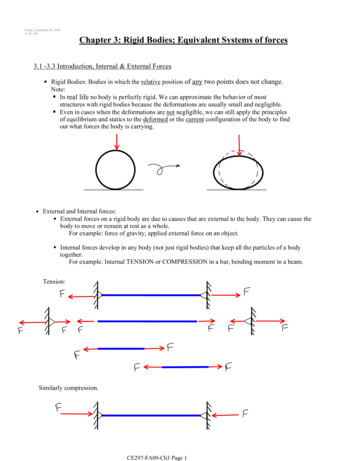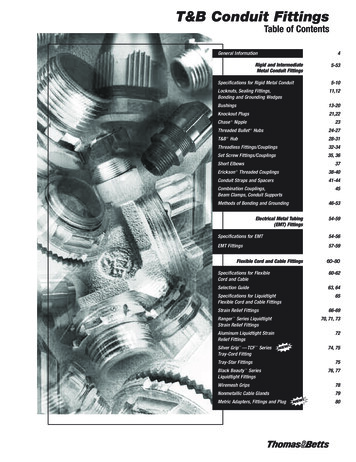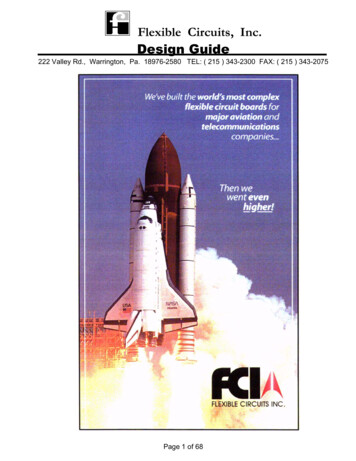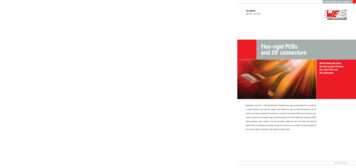
Transcription
Friday, September 04, 200911:26 AMChapter 3: Rigid Bodies; Equivalent Systems of forces3.1 -3.3 Introduction, Internal & External Forces Rigid Bodies: Bodies in which the relative position of any two points does not change.Note: In real life no body is perfectly rigid. We can approximate the behavior of moststructures with rigid bodies because the deformations are usually small and negligible. Even in cases when the deformations are not negligible, we can still apply the principlesof equilibrium and statics to the deformed or the current configuration of the body to findout what forces the body is carrying. External and Internal forces: External forces on a rigid body are due to causes that are external to the body. They can cause thebody to move or remain at rest as a whole.For example: force of gravity, applied external force on an object. Internal forces develop in any body (not just rigid bodies) that keep all the particles of a bodytogether.For example: Internal TENSION or COMPRESSION in a bar, bending moment in a beam.Tension:Similarly compression.CE297-FA09-Ch3 Page 1
Wednesday, September 09, 20097:52 AM3.4 -3.8 Moment of a force; Vector CROSS Product Any force that is applied to a rigid body causes the body to translate or ROTATE or both. The tendency to ROTATE is caused by MOMENTS generated by the force. In general, a force F generates a moment about any point O which is offset by some distancefrom the line of action of F.Note: Moment of F about O. Moment is a VECTOR.CE297-FA09-Ch3 Page 2
Wednesday, September 09, 20098:59 AMVector Cross Product: Vector product of two vectors P and Q is definedas the vector V which satisfies the followingconditions:1. Line of action of V is perpendicular to planecontaining P and Q.2. Magnitude of V is V P Q sin θ3. Direction of V is obtained from the right-handrule. Vector products:- are not commutative, Q P ( P Q )P (Q1 Q2 ) P Q1 P Q2- are distributive,- are not associative, ( P Q ) S P (Q S ) Vector products of Cartesian unit vectors, i i 0j i k k i j i j kj j 0k j i i k j j k ik k 0 Vector products in terms of rectangularcoordinates V (Px i Py j Pz k ) (Q x i Q y j Q z k ) ( Py Qz Pz Qy ) i ( Pz Qx Px Qz ) j ( Px Qy Py Qx ) kThus Moment of F about O can be obtained as:CE297-FA09-Ch3 Page 3
Wednesday, September 09, 20099:31 AMVarignon's Theorem r (F1 F2 ) r F1 r F2 Follows from the Distributive property of the vector cross product Varigon’s Theorem makes it possible to replace the direct determination of themoment of a force F by the moments of two or more component forces of F.Equivalent forcesTwo forces are said to be equivalent if they have the same magnitude and direction (i.e. they are equal)and produce the same moment about any point O (i.e. same line of action).Note: Principle of transmissibility follows from this. Two forces that have the same line of action producethe same external effect (i.e.translation or rotation) on the body because they have the same net forceand moment about any point. Later in Chapter 4 we will see that the equations for equilibrium for a rigid bodyare given by:Applications of Cross product: Finding the direction perpendicular to two vectors. Calculation of Area of a Parallelogram. Finding the distance of a point from a line.Examples:CE297-FA09-Ch3 Page 4
Monday, September 14, 20096:07 PMRead Examples 3.2, 3.3, 3.4.Example 3.1A 100-lb vertical force is applied to the end of a lever which is attached to a shaft at O.Determine:a)b)c)d)e)moment about O,horizontal force at A which creates the same moment,smallest force at A which produces the same moment,location for a 240-lb vertical force to produce the same moment,whether any of the forces from b, c, and d is equivalent to the original force.CE297-FA09-Ch3 Page 5
Friday, September 11, 20099:37 AMExercise 3.25 & 3.31Given tension in each cable is 810N. Determine the moment at A due to the force at D. Find the distance of point A from the "line" DE.Recall Moment of F about A can be obtained as:CE297-FA09-Ch3 Page 6
Monday, September 14, 200911:13 AM3.9 Scalar Product of two Vectors The scalar product or dot product between two vectors Pand Q is defined as P Q PQ cosθ (scalar result) Scalar products: are commutative, are distributive, are not associative, P Q Q P P (Q1 Q2 ) P Q1 P Q2 (P Q ) S undefined Scalar products with Cartesian unit components, P Q (Px i Py j Pz k ) (Qx i Q y j Qz k ) i i 1 j j 1 k k 1 i j 0 j k 0 k i 0 P Q Px Qx Py Q y Pz Qz P P Px2 Py2 Pz2 P 2Applications of Dot Product Work done by a forceW F d F d cosθ Angle between two vectors: P Q PQ cos θ Px Qx Py Q y Pz Qzcos θ Px Qx Py Q y Pz QzPQ Projection of a vector on a given axis:POL P cosθ projection of P along OL P Q PQ cosθ P Q P cosθ POLQ Component in a given direction (unit vector): POL P λ Px cos θ x Py cos θ y Pz cos θ zCE297-FA09-Ch3 Page 7
3.10 Mixed TRIPLE Product of 3 Vectors Mixed triple product of three vectors, S (P Q ) scalar result The six mixed triple products formed from S, P, and Qhave equal magnitudes but not the same sign, S (P Q ) P (Q S ) Q (S P ) S (Q P ) P (S Q ) Q (P S ) Evaluating the mixed triple product, S (P Q ) S x (Py Q z Pz Q y ) S y ( Pz Q x Px Q z ) S z (Px Q y Py Q x )SxSySz PxPyPzQxQyQz3.11 Moment of a force about an AxisNote: MOL is the projection of MO along OL.Application:Finding the perpendicular distance betweentwo non-intersecting lines in 3D space.Read Example 3.5 in the book.A cube is acted on by a force P as shown. Determine the moment of Pa)b)c)d)about Aabout the edge AB andabout the diagonal AG of the cube.Determine the perpendicular distance between AG and FC.CE297-FA09-Ch3 Page 8
Wednesday, September 16, 20099:48 AM3.12-3.13 Force Couples Two forces F and -F having the same magnitude, parallellines of action, and opposite sense are said to form a couple. Moment of the couple, M rA F rB ( F ) (rA rB ) F r FM rF sin θ FdNote: Moment of a "couple" is always the same about any point.Equivalent CouplesTwo or more couples are equivalent iff they produce the same moment. F1d1 F2 d2 the two couples lie in parallel planes, and the two couples have the same sense or the tendency to cause rotation in thesame direction.3.14-3.15 Couples (and Moments) are VectorsCE297-FA09-Ch3 Page 9
Addition of CouplesMoment due to the resultant of the forces: M r R r (F1 F2 )Moment due to the individual couples: M 1 r F1 in plane P1 M 2 r F2 in plane P2VECTOR sum of the two moments: M r F1 r F2 M1 M 2Example 3.63.16 Equivalent Force and MomentCE297-FA09-Ch3 Page 10
Wednesday, September 16, 20094:21 PM3.17-3.18 Equivalent Systems of Forces & Moments Any system of forces can be reduced to ONE resultant force and ONE resultant moment. Once a resultant force & moment has been found about O, a new resultantforce & moment about a different point 0' can be found as follows: Two or more systems of forces & Moments are said to be equivalent iff they havethe same resultant force and the resultant moment about any (and all) points O.CE297-FA09-Ch3 Page 11
Thursday, September 17, 200910:08 PM3.20 Special Case: Reduction to a SINGLE forceIn general, a system of forces and moments cannot be reduced to just a single force.However, if the resultant moment is perpendicular to the resultant force, one canreduce the system to just ONE force and NO moment.Particular cases: Concurrent forces: Forces acting at the same point. Coplanar forces: Forces contained in the same plane (with non-concurrent lines of action) Parallel forces in 3D space.CE297-FA09-Ch3 Page 12
Thursday, September 17, 200910:50 PMExample 3.8Reduce the forces to an equivalent force & moment at A at BReduce them to SINGLE force and find where it acts.Exercise 3.88The shearing forces exerted on the cross section of a steel channelcan be represented as 900N vertical and two 250 N horizontal forces. Replace these forces with a SINGLE force at C.(C is called the shear center) Determine x.CE297-FA09-Ch3 Page 13
CE297-FA09-Ch3 Page 14
Chapter 3: Rigid Bodies; Equivalent Systems of forces Rigid Bodies: Bodies in which the relative position of any two points does not change. In real life no body is perfectly rigid. We can approximate the behavior of most structures with rigid bodies b










